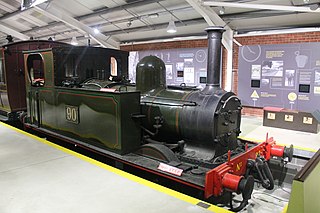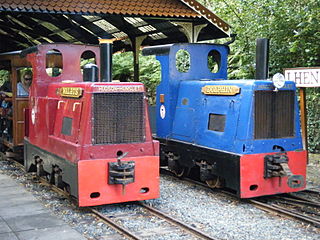
The Snowdon Mountain Railway is a narrow gauge rack-and-pinion mountain railway in Gwynedd, north-west Wales. It is a tourist railway that travels for 4.7 miles (7.6 km) from Llanberis to the summit of Snowdon, the highest peak in Wales. A return journey, including the stop at the summit, takes 2½ hours.

The London, Midland and Scottish Railway (LMS) Coronation Class is a class of express passenger steam locomotives designed by William Stanier. They were an enlarged and improved version of his previous design, the LMS Princess Royal Class, and on test were some of the most powerful steam locomotives ever used in Britain at 2,511 dbhp. The locomotives were specifically designed for power as it was intended to use them on express services between London Euston and Glasgow Central; their duties were to include the hauling of a proposed non-stop express, subsequently named the Coronation Scot.

4464Bittern is a London and North Eastern Railway (LNER) Class A4 steam locomotive. Built for the LNER and completed on 18 December 1937 at Doncaster Works as works number 1866, it received number 4464. After that it was renumbered 19 on 16 August 1946 under the LNER 1946 renumbering scheme, and finally 60019 by British Railways on 10 October 1948, after nationalisation. Of the 35 strong class, it is one of six to survive into preservation but it is one of only two currently scheduled to be certified for mainline use.

4489 Dominion of Canada is an LNER Class A4 steam locomotive. It is a 4-6-2 locomotive built to the same design by Sir Nigel Gresley as the more famous Mallard. There were 35 A4 locomotives built in total. Originally numbered 4489, it was renumbered 10 on 10 May 1946, under the LNER 1946 renumbering scheme of Edward Thompson and, after nationalisation in 1948, British Railways added 60000 to its number so it became 60010 on 27 October 1948. It was renumbered back to 4489 following a cosmetic restoration at the National Railway Museum in York during late 2012 and early 2013.

The British Rail Class 20, otherwise known as an English Electric Type 1, is a class of diesel-electric locomotive. In total, 228 locomotives in the class were built by English Electric between 1957 and 1968, the large number being in part because of the failure of other early designs in the same power range to provide reliable locomotives.

The British Rail Class 59 is a fleet of Co-Co diesel-electric locomotives built between 1985 and 1995 by the Electro-Motive Division of General Motors for use in Great Britain. A total of 15 locomotives were built for three different operators.

The Midland Railway 115 Class was the third of four classes of 4-2-2 steam locomotive, nicknamed "Spinners", designed by Samuel Waite Johnson. A total of 15 of the class were built between 1896 and 1899. They were capable of reaching speeds of up to 90 miles per hour (145 km/h). One engine, No. 673, is preserved in the National Collection.

The Leader was a class of experimental 0-6-0+0-6-0T steam locomotive, produced in the United Kingdom to the design of the innovative engineer Oliver Bulleid. The Leader was an attempt to extend the life of steam traction by eliminating many of the operational drawbacks associated with existing steam locomotives. It was intended as a replacement for the ageing fleet of M7 class tank engines still in operation on the Southern Railway (SR). Design work began in 1946 and development continued after the nationalisation of the railways in 1948, under the auspices of British Railways (BR).

The Great Southern and Western Railway Class 90 is a class of 0-6-0T steam locomotive. They were one of the smallest steam locomotives to be inherited by the CIÉ on its formation.
This is a list of jargon commonly used by railfans and railway employees in New Zealand.

LNER Peppercorn Class A1 No. 60163 Tornado is a 4-6-2 steam locomotive completed in 2008 to an original design by Arthur Peppercorn. It is the first new build British mainline steam locomotive since 1960, and the only Peppercorn Class A1 in existence after the original batch were scrapped. In 2017, Tornado became the first steam locomotive to officially reach 100 mph (160 km/h) on British tracks in over 50 years.

The GS&WR Class 101, classified as Class 101 or Class J15 by the Great Southern Railways, was a class of 0-6-0 steam locomotives designed for working goods traffic although they did, and were quite capable of, working branch and secondary passenger trains.

The SECR N class was a type of 2-6-0 ("mogul") steam locomotive designed in 1914 by Richard Maunsell for mixed-traffic duties on the South Eastern and Chatham Railway (SECR). Built between 1917 and 1934, it was the first non-Great Western Railway (GWR) type to use and improve upon the basic design principles established by GWR Chief Mechanical Engineer (CME) George Jackson Churchward. The N class was based on the GWR 4300 Class design, improved with Midland Railway concepts.
The rolling stock used on the Isle of Man Railway today is entirely original although, from an original total of 75 carriages, the number serviceable dropped as low as 14, but this total is once again increasing as a result of recent rebuilds The 3 ft gauge railway was provided with a variety of stock from different manufacturers over its time, and types of coach were categorised according to a lettering system, with the original four-wheeled coaches being of A, B, C and D types, and so on. The F prefix encompassed all bogie vehicles including conversions from the A-D series. Letters G-M denoted goods stock. N referred to ex-Manx Northern Railway 6 wheel carriages. The types of stock can be summarised as follows:-
The locomotives of the Isle of Man Railway were provided exclusively by Beyer, Peacock & Company of Manchester, England between 1873 and 1926; other locomotives that appear on this list were inherited as part of the take-over of the Manx Northern Railway and Foxdale Railway in 1905, when the railway also purchased two more locomotives from Beyer, Peacock. All the steam locomotives have or had the 2-4-0T wheel arrangement, apart from No. 15 Caledonia which is an 0-6-0T.

The history of British Rail's corporate liveries is quite complex. Although the organisation was associated with Rail Blue from the mid-1960s to the 1980s, a number of other schemes were also used, especially when it was split into operating units in the mid-1980s.

Dolphin and Walrus are diesel locomotives that are operated on the Groudle Glen Railway.

Milk tank wagons were a common sight on railways in the United Kingdom from the early 1930s to the late 1960s. Introduced to transport raw milk from remote dairy farms to central creameries, milk trains were the last railway-based system before the move to road transport.
The GS&WR 400 class or CIE class B2/B2a were a class of ten 4-6-0 steam locomotives built for the Great Southern & Western Railway (GS&WR) between 1916 and 1923 for express passenger duties on the Dublin to Cork main line. They proved initially unreliable but rebuilds from four to two cylinders between 1927 and 1937 for the seven survivors produced locomotives yielding satisfactory performance with the last two being withdrawn in 1961.

A builder's photo, also called an official photo, is a specific type of photograph that is typically made by rail transport rolling stock manufacturers to show a vehicle that has been newly built or rebuilt. The builder's photo is meant to show an overview of the basic exterior form of a unit of rolling stock. Photographs made by railfans that show similar features to builder's photos are sometimes informally referred to as roster shots. Builder's photos were also made by some automobile manufacturers to show a representative sample of new models they produced.



















